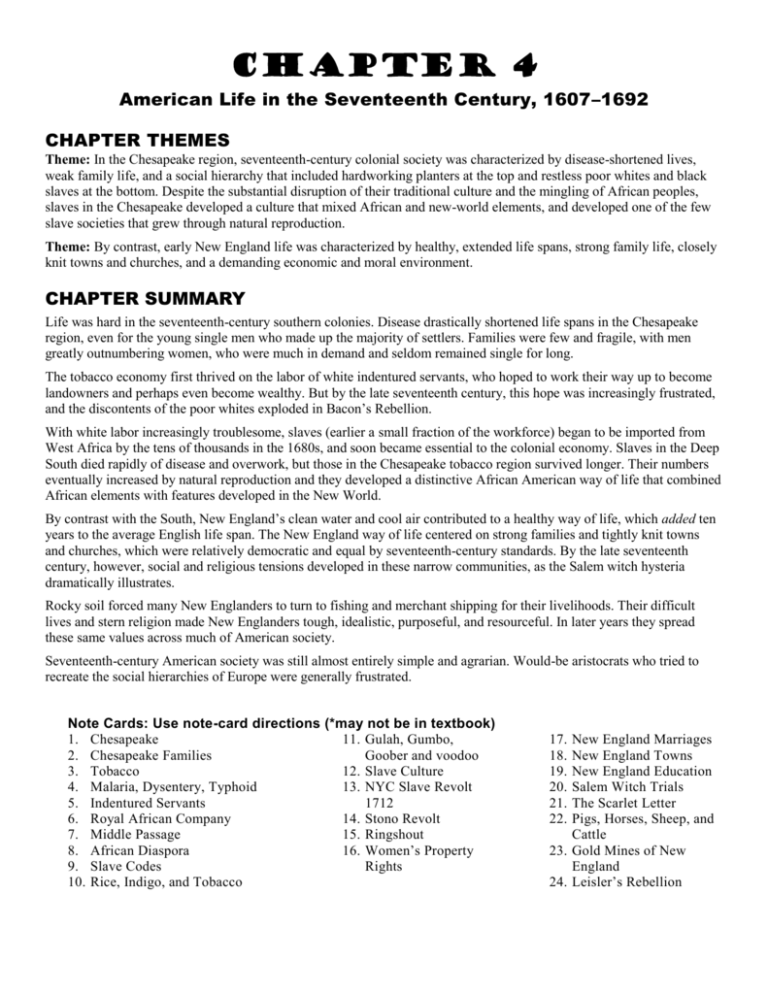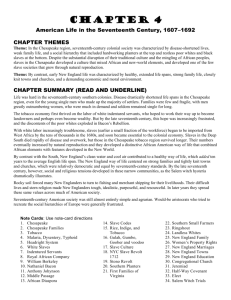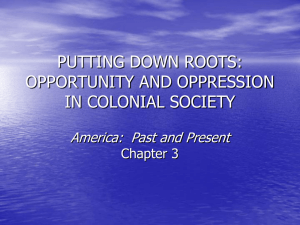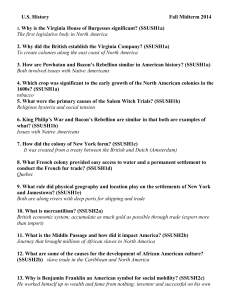CHAPTER 4
advertisement

Chapter 4 American Life in the Seventeenth Century, 1607–1692 CHAPTER THEMES Theme: In the Chesapeake region, seventeenth-century colonial society was characterized by disease-shortened lives, weak family life, and a social hierarchy that included hardworking planters at the top and restless poor whites and black slaves at the bottom. Despite the substantial disruption of their traditional culture and the mingling of African peoples, slaves in the Chesapeake developed a culture that mixed African and new-world elements, and developed one of the few slave societies that grew through natural reproduction. Theme: By contrast, early New England life was characterized by healthy, extended life spans, strong family life, closely knit towns and churches, and a demanding economic and moral environment. CHAPTER SUMMARY Life was hard in the seventeenth-century southern colonies. Disease drastically shortened life spans in the Chesapeake region, even for the young single men who made up the majority of settlers. Families were few and fragile, with men greatly outnumbering women, who were much in demand and seldom remained single for long. The tobacco economy first thrived on the labor of white indentured servants, who hoped to work their way up to become landowners and perhaps even become wealthy. But by the late seventeenth century, this hope was increasingly frustrated, and the discontents of the poor whites exploded in Bacon’s Rebellion. With white labor increasingly troublesome, slaves (earlier a small fraction of the workforce) began to be imported from West Africa by the tens of thousands in the 1680s, and soon became essential to the colonial economy. Slaves in the Deep South died rapidly of disease and overwork, but those in the Chesapeake tobacco region survived longer. Their numbers eventually increased by natural reproduction and they developed a distinctive African American way of life that combined African elements with features developed in the New World. By contrast with the South, New England’s clean water and cool air contributed to a healthy way of life, which added ten years to the average English life span. The New England way of life centered on strong families and tightly knit towns and churches, which were relatively democratic and equal by seventeenth-century standards. By the late seventeenth century, however, social and religious tensions developed in these narrow communities, as the Salem witch hysteria dramatically illustrates. Rocky soil forced many New Englanders to turn to fishing and merchant shipping for their livelihoods. Their difficult lives and stern religion made New Englanders tough, idealistic, purposeful, and resourceful. In later years they spread these same values across much of American society. Seventeenth-century American society was still almost entirely simple and agrarian. Would-be aristocrats who tried to recreate the social hierarchies of Europe were generally frustrated. Note Cards: Use note-card directions (*may not be in textbook) 1. Chesapeake 11. Gulah, Gumbo, 2. Chesapeake Families Goober and voodoo 3. Tobacco 12. Slave Culture 4. Malaria, Dysentery, Typhoid 13. NYC Slave Revolt 5. Indentured Servants 1712 6. Royal African Company 14. Stono Revolt 7. Middle Passage 15. Ringshout 8. African Diaspora 16. Women’s Property 9. Slave Codes Rights 10. Rice, Indigo, and Tobacco 17. 18. 19. 20. 21. 22. New England Marriages New England Towns New England Education Salem Witch Trials The Scarlet Letter Pigs, Horses, Sheep, and Cattle 23. Gold Mines of New England 24. Leisler’s Rebellion Chapter 4 Study Guide Chapter Questions: Write a detailed answer for each. The Unhealthy Chesapeake 1. "Life in the American wilderness was nasty, brutish, and short for the earliest Chesapeake settlers." Explain. The Tobacco Economy 2. What conditions in Virginia made the colony right for the importation of indentured servants? Frustrated Freemen and Bacon's Rebellion 3. Who is most to blame for Bacon's rebellion, the upper class or the lower class? Explain. Colonial Slavery 4. Describe the slave trade. Africans in America 5. Describe slave culture and contributions. Makers of America: From African to African-American 6. "And precisely because of the diversity of African peoples represented in America, the culture that emerged was a uniquely New World creation." Explain. Southern Society 7. Describe southern culture in the colonial period, noting social classes. The New England Family 8. What was it like to be a woman in New England? 9. How was family life in New England different from that of the Chesapeake and the South? Life in the New England Towns 10. Explain the significance of New England towns to the culture there. 11. Contrast New England towns with those of more Southern Colonies. The Half-Way Covenant and the Salem Witch Trial 12. What evidence shows that New England was becoming more diverse as the 17th century wore on? The New England Way of Life 13. How did the environment shape the culture of New England? The Early Settlers' Days and Ways 14. How much equality was evident in the colonies? Analysis Questions 1. Why was family life in New England so different from family life in the South? 2. Why did slavery grow to be such an important institution in colonial America? What were the effects of slavery on the Africans who were brought to the New World? What were the effects of the Africans on the New World? 3. What was attractive and unattractive about the closely knit New England way of life? 4. Were the Salem witch trials a peculiar, aberrant moment in an age of superstition, or did they reflect common human psychological and social anxieties that could appear in any age? How harshly should those who prosecuted the “witches” be condemned? 5. Explain the search for a suitable labor supply in the plantation colonies, contrasting the relative advantages and disadvantages of white indentured servants and slaves (from the planters’ point of view). Perhaps use Bacon’s Rebellion as the clearest illustration of why planters feared uncontrolled laborers and turned increasingly to slavery. “Albeit the business of this witchcraft may be very much transacted upon the stage of imagination, yet we know that, as in treason, there is an imagining which is a capital crime, and here also the business, though managed in imagination, yet may not be called imaginary. The effects are dreadfully real.… Our neighbors at Salem Village are blown up, after a sort, with an infernal gunpowder; the train is laid in the laws of the kingdom of darkness…. Now the question is, who gives fire to this train? And by what acts is the match applied?” (1692) Cotton Mather (1662–1728) 6. Considering the extreme differences during the seventeenth-century between New England and the southern colonies, was the Civil War inevitable? “For having upon specious pretences of publick works raised greate unjust taxes upon the commonality for the advancement of private favorites and other sinister ends…for having wronged his Majesty’s prerogative and interesting by assuming monopoly of the beaver trade…and for having protected, favored, and imboldened the Indian’s against his Majesty’s loyall subjects…we do demand that the said Sir William Berkeley…be forthwith delivered up or surrender [himself] within four days of this notice forthwith.” (Declaration of the People, 1676) Nathaniel Bacon (1647–1676) 7. How did slavery vary among the different regions of the Americas? How did cultural elements of the slaves survive in these different environments? 8. Discuss women’s lives in the seventeenth century, including economic functions, religion, marriage, and child raising. How did the economic and social importance of women in agrarian colonial communities, as well as on the legal and political restrictions that keep them tied to men? 9. What role did unfree labor play in colonial American society? 10. Although many Northerners and Southerners came later to think of themselves as having separate civilizations, the Northern and Southern colonies in the seventeenth and eighteenth centuries were in fact more similar than different. Assess the validity of this statement. 11. Throughout the colonial period, economic concerns had more to do with the settling of British North America than did religious concerns. Assess the validity of this statement with specific reference to economic and religious concerns. 12. Analyze the extent to which religious freedom existed in the British North Ameri can colonies prior to 1700. 13. How did economic, geographic, and social factors encourage the growth of slavery as an important part of the economy of the southern colonies between 1607 and 1775? 14. Analyze the impact of the Atlantic trade routes established in the mid 1600’s on economic development in the British North American colonies. Consider the period 1650-1750. 15. Compare the ways in which TWO of the following reflected tensions in colonial society. Bacon’s Rebellion (1676) Pueblo Revolt (1680) Salem witchcraft trials (1692) Stono Rebellion (1739) 16. Compare and contrast the ways in which economic development affected politic s in Massachusetts and Virginia in the period from 1607 to 1750. 17. Early encounters between American Indians and European colonists led to a variety of relationships among the different cultures. Analyze how the actions taken by BOTH American Indians and European colonists shaped those relationships in TWO of the following regions. Confine your answer to the 1600’s. New England Chesapeake Spanish Southwest New York and New France HISTORIC NOTES Social-class conflict is a key element in the revisionist interpretation of American historical development. Always under the surface of colonial societies, it erupts into full-scale civil war with Bacon’s Rebellion, in VA. The introduction of slavery into the New World transforms the social, economic, and political makeup of the colonies. The primary source of African slaves is west-central Africa. Religious hysteria in the form of witch trials plague the North American colonies, especially in New England settlements. European class-based customs, such as the wearing of fancy jewelry by certain segments of society, do not find fertile ground in the more democratic New World English colonies. Although initially an area where settlement barely survived, the Chesapeake colony region soon spawned a powerful industry: cultivating and selling tobacco. So important was this crop that it helped maintain the economy of the region and, because of its tendency to exhaust the soil, led to westward penetration of the Chesapeake colonies. The social life and customs of the North American colonists were considerably shaped and affected by where they lived. Unique cultural traits took root in the New England, middle, and southern colonies. Despite the presence of slavery in the colonies, white settlers were not so quick to nurture the type of social stratification that prevailed in Europe. Advanced Placement United States History Topic Outline 1. Transatlantic Encounters and Colonial Beginnings, 1492-1690 A. First European contacts with Native Americans B. Spain's empire in North America C. French colonization of Canada D. English settlement of New England, the Mid-Atlantic region, and the South E. From servitude to slavery in the Chesapeake region F. Religious diversity in the American colonies G. Resistance to colonial authority: Bacon's Rebellion, the Glorious Revolution, and the Pueblo Revolt 2. Colonial North America, 1690-1754 A. Population growth and immigration B. Transatlantic trade and the growth of seaports C. The eighteenth-century back country D. Growth of plantation economies and slave societies E. The Enlightenment and the Great Awakening F. Colonial governments and imperial policy in British North America









